Burlesque
Even yet more about various old, feared, and/or hated forms of clowning: a sexy vocab word for the week.
Back in 2015, my husband and I agreed to a divorce. Well, more like I told him it was time and he seemed surprised. We had opened up our marriage a couple years before that (because that’s a fantastic thing to do for a marriage on the rocks), and so I was dating a bit, and feeling a lot more myself than I had been sexually for more than a decade of being isolated by a gaslighter. I picked up my old writing again, I got involved in more fight direction myself (instead of merely assisting my husband), and right as I was finally about to move out on my own, I found a new theatrical hobby, which today is almost more of a side-hustle. This beautiful and boisterous art form is called burlesque.
I first got into burlesque when I was working as a reviewer for the Boulder International Fringe Fest, a very well-known stop on the global Fringe circuit. One of the shows I took in was a burlesque showcase put on by a local troupe. In this show, one of their group pieces incorporated audience members: they invited anyone in the audience who wanted, to come up onstage and join them in a little improv, taking off as many clothing items as desired. No idea why I decided to try it, but I did so, and I had a blast. So I decided to take their workshop and ‘graduation’ performance and become a burlesque performer. It’s been my hobby ever since.
I won’t tell you the name of that first company I joined, as I had a pretty disappointing overall experience with them (more about this experience in my memoir), but suffice to say I learned a little about what goes into burlesque, how it’s connected to drag, and learned a lot about costuming for same. When I quit that group, then after when the second troupe I danced with also imploded, and my friend turned to me and asked if I wanted to start our own group, I said Hell yes!
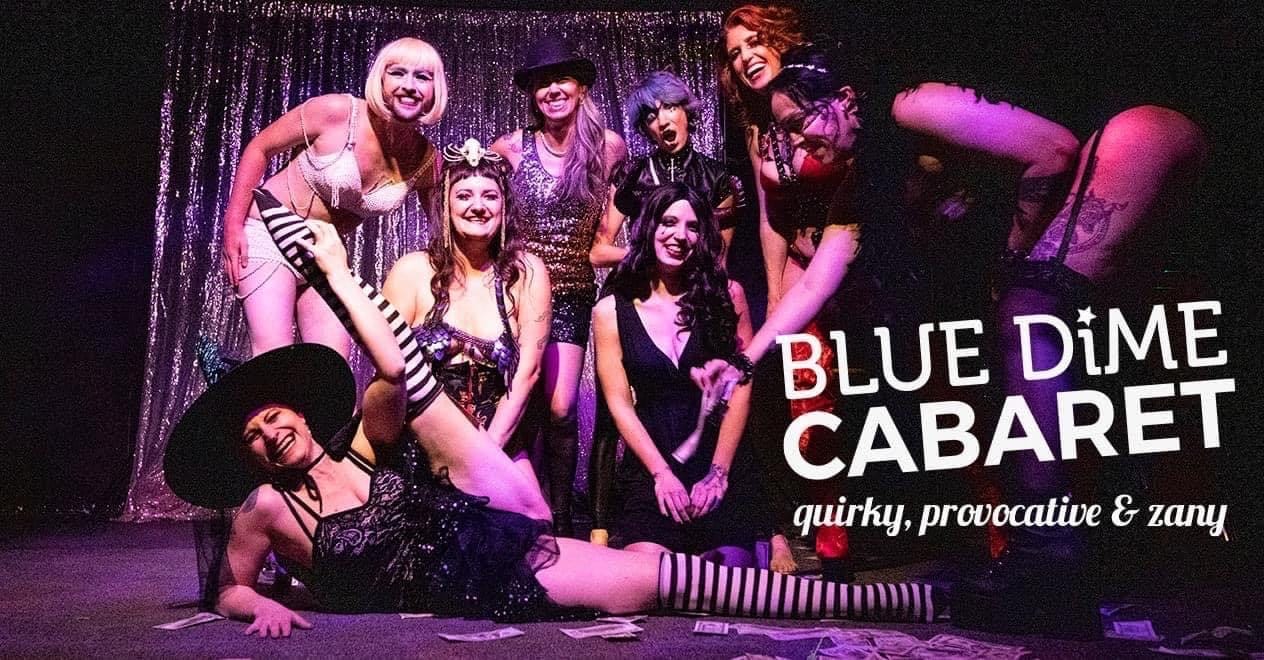
Now, our pop-up vaudeville company Blue Dime Cabaret puts on shows at least once a month, in which I often perform, though not always burlesque. I also guest spot in various other local groups, so my burlesque hobby has become quite robust since I first tentatively tried it nearly a decade ago.
Burlesque - huh - What it is Good For
What is burlesque? Well, it is known as ‘the art of the tease,’ and so it basically is stripping (even though it’s not). Each burlesque act involves dancing to a piece of music, and throughout, having points at which the dancer does what’s called a ‘reveal.’ What’s a reveal? It’s a taking off of an item of clothing—some reveals are huge, like ripping off a pair of tearaway track pants; or tiny, like the removal of a glove, or taking one’s hair down. A friend of mine created a piece with such exquisite tension, that she has yet to perform on a stage but I so wish she would: her piece consists of her, seated, elegantly dressed, slowly and elastically lighting a cigarette in a holder. The whole song is her smoking that cigarette, with the only reveal a slow, finger by finger removal of only one of her opera gloves.
A burlesque dancer will usually, though, strip down to undies and pasties. The old-fashioned rule of burlesque is that all genitals and any female-presenting nipples must be covered, but many men burlesquers these days will cover theirs too, in solidarity (though I don’t know of a single burlesque artist who needs an excuse to add something sparkly to their costume). Pasties can be anything from plain black tape Xes (a form I prefer) to big jewel-encrusted works of art, to dangling tassels of all kinds. We had one burlesque artist back in one of our earlier shows, who lit her tassels on fire, and twirled the miniature flames to the alarm and delight of the audience. I myself have an act to Siouxsie’s song “Peek a Boo” that involves pasties made from plus size googly eyes. There’s also a thing called ‘assels,’ which are just pastie tassels but worn on the butt instead of the boobs.
What is burlesque not? It’s not stripping (even though it is). At least, it’s not the kind of stripping you’ll find in a strip club. For one thing, burlesque artists never go all-nude, though some burlesque artists will do so in different venues, say for example if they also work at a strip club or as a cam girl. I don’t actually know what the laws are specifically, but I do know that in most regular venues like theaters and bars, a burlesque show is not allowed to strip totally nude. One exception I’ve experienced to this rule is when we were scheduled to perform at a BDSM club for their club night, as opposed to in a theatre or on a stage. But that’s blurring the boundary between burlesque as theatre and as sex work, though it is widely considered to be both. To me, it’s the difference in feeling, from a more one-on-one transactional type thing in a strip club vs. a theatrical spectacle on a big stage to a large audience.
Burlesque also is not gogo dancing, even though both arts do have aspects in common. A gogo dancer normally will be scantily clad but won’t strip further than that, and is meant to be an ornamental backdrop to the music, as opposed to the focus in a spotlight. They’ll improvise movement for several songs in a row instead of doing set choreography for one.
But all this is rather splitting hairs of definition: basically, burlesque involves wearing sparkles, and then choreographedly taking them off. More fun facts: a ‘kitten’ is a stagehand, often a beginner burlesquer, dressed in cute togs and kitten ears, whose job it is to set up props or sets, and clear any dropped clothing (and sometimes tossed tips). Many burlesque dancers will wear a layer of flesh-colored fishnets under their outfit as a sort of extra modesty layer, and it’s considered a basic costume piece for burlesque in particular.
Origin Story
People have been artistically taking their clothes off onstage since forever, but burlesque as we know it today began mainly within the big vaudeville crazes of Europe in the cabarets of the 18th and 19th centuries. The original meaning of the word refers to a parody or satire, and that’s usually what burlesques were back in the day: ribald parodies and costume play, impersonators and gender messers-with. Later, as performers like Vegas showgirls and subversive acts like those of Betty Page came around, the term came to mean a theatrical stripper, not necessarily a satirist. Though many burlesque and drag acts are still impersonations or parodic homages. This history of parodic origins may be why stage names for burlesque (and drag) are always very punny and innuendo-laden.
Burlesque is still a lowbrow form of entertainment (I’ve been calling it an art form throughout this article but many people won’t give it that credit, even still). Burlesque, since it does incorporate provocative sexiness and stripping, does get denigrated especially when compared with other theatrical arts. Burleque has seen a big revival in recent years and has been getting a lot more mainstream attention, but even still, it isn’t widely regarded as anything particularly respectable, and in the US’s recent upsurge of anti-drag queerphobia, transphobia, and general misogyny, in some regions especially, it’s not that many steps up to some people, from prostitution or certainly stripping in a club.
My experience doing burlesque, however, hasn’t been one of exploitation or denigration, far from it—I’ve felt celebrated and have been cast as major roles so much more than in standard theatre, and in my big body, I haven’t been looked over for casting because I’m not small or thin or feminine enough to be castable. My being larger than life is an advantage in burlesque. And oh man, when you’ve got body dysmorphia or are weird about your body for any reason, to have a big crowd cheer as you expose it is one of life’s greatest empowering highs. I do a piece to the Commodores’ “Brick House” where I end up emphasizing and demanding audience cheers for my big belly. They absolutely love it, every time. It’s hard for me to hate my fatness when it’s so celebrated and loved by so many people. It’s fricking therapeutic.
Our goals in Blue Dime Cabaret embrace this: we’ve been widely called one of the most inclusive, high-quality groups in Denver, and that’s saying a lot, since the burlesque scene is so prolific here. Our goal is to be a safe space for everyone, and to empower each human that appears on our stage, whether they’re a fully clothed standup or stripping all the way down to their pasties, or anything in between. Having said that, I am the one in charge of casting, and I have very high standards.
The co-producers of Blue Dime Cabaret always have a moment where we talk about our group and future shows, etc. onstage, as a kind of breather. My co-producer, Brandy, is a gorgeous, silver-haired beauty with a slamming bod. I’m a big D&D-looking barbarian with a beer belly, even bigger in heels. Usually, we banter: I’ll divert the audience’s attention to her abs and declare: “abs of CrossFit,” to many hoots and cheers. Then I’ll lift whatever garment I’m wearing and declare, “abs of craft beer.” The even louder cheers and whistles to my (to me) gross looking belly make me second guess my perspective on my own body, every time. Burlesque isn’t degrading; it’s empowering.
Hybrid forms
There’s a lot to be said for the old-school basic art of the tease, which is called Classic Burlesque these days, but in burlesque’s recent resurgence, artists are combining a bunch of their other talents along with the burlesque, creating new and funky forms that are super fun to watch.
Draglesque
You can actually pretty much add the suffix ‘-lesque’ onto any number of things and make a burlesque subgenre (‘nerdlesque’ is one I’ve seen around quite a bit lately and which I personally have a lot of fun with), but one of the most lasting and legit of these is draglesque. Draglesque is just what it sounds like: a combination of drag and burlesque. Usually, a drag act doesn’t involve reveals (or stripping), at all, and does include lip-syncing to the song the performer is dancing to. Burlesque, on the other hand, does involve reveals and does not involve lip-syncing, just dance. What makes draglesque so much fun is that you’ve got the combination of all aspects of both arts: a striptease with outlandish costumes and makeup, the former of which gets stripped artfully, while the lipsyncing skill is in play. One of Blue Dime Cabaret’s most-cast draglesque artists (one Blass Femme) even sometimes sings live, instead of lip-syncing. Pretty impressive.
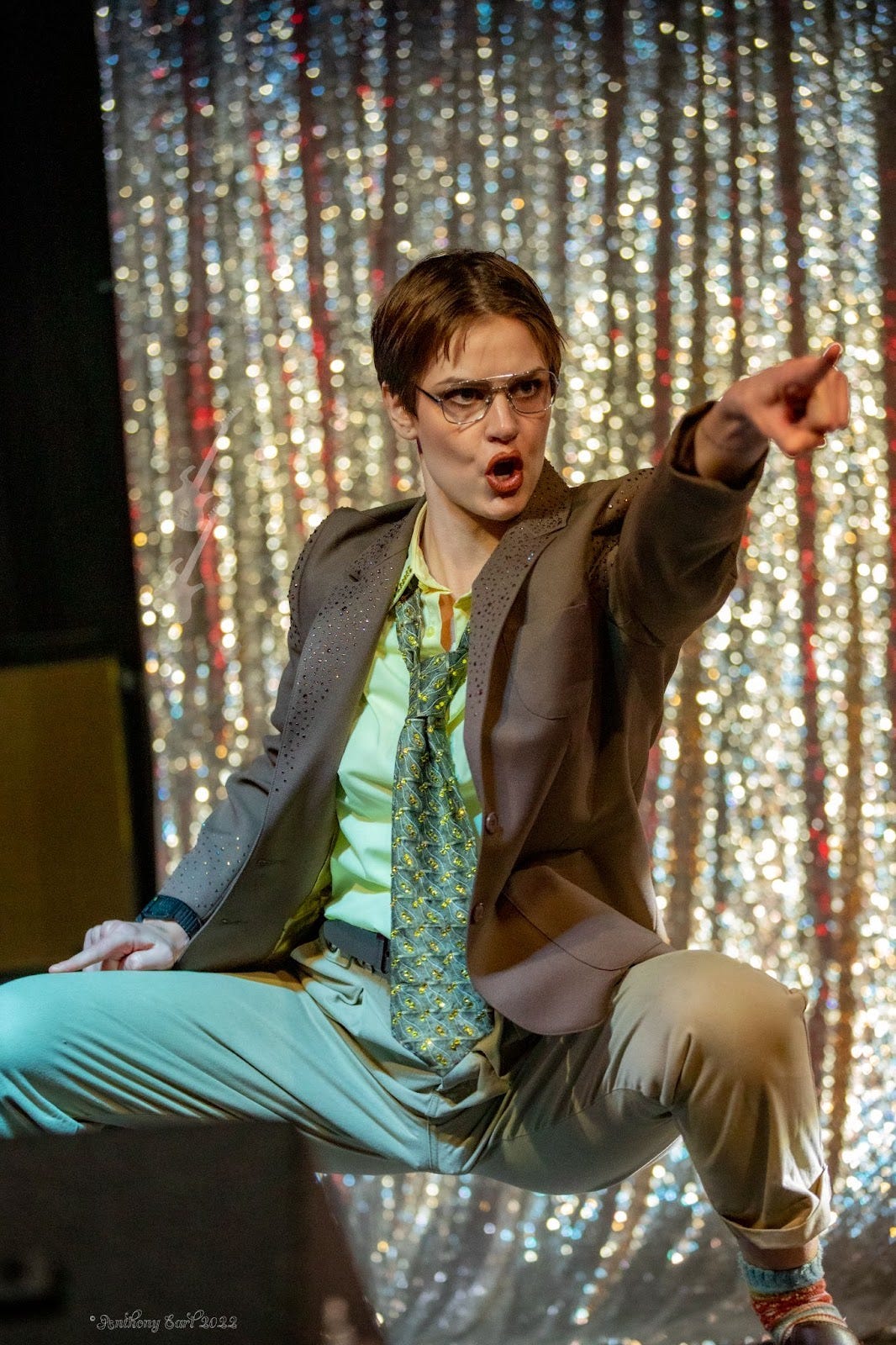
Boylesque
This term simply refers to a masculine presenting person doing a burlesque act, and as such, isn’t a term that’s really used very often anymore in today’s burlesque scene. Gender bending and gender play are much more widespread in burlesque these days, with especially drag arts melding together with it seamlessly. Boys doing burlesque, in other words, are just doing burlesque—boylesque isn’t a separate discrete thing.
Kink
This is a similarly old performing art to burlesque, that has stayed mainly underground in the BDSM and even goth subcultures, even today. But you’ll sometimes get burlesque artists that appear in kink displays, doing a little more of an edgy type of act, or every once in a while you’ll come across a kink-themed burlesque show that includes kink acts along with darker, more dangerous burlesque. Things I’ve seen lately in this vein are: fire breathing, spark grinding, self-flagellation, and the like. Just the other day in fact, I was in a burlesque show that included an old school strongman act, wherein the performer broke through heavy chains that bound him, and cracked his locked wrist shackles in a part stage-magic, part kink, part burlesque reveal.
Combinations
Beyond these hybrid subgenres, you’ve also got burlesque paired with other types of performance, especially in a live-theatre-rich town like Denver, where talent is rampant. Some of these mixed acts that Blue Dime Cabaret likes to do include: Singing & stripping* (instead of the more usual draglesque with lip-syncing added), reveals built into other forms of dance (like belly dance, acro, pole, and aerial). We’ve even got performers who combine stripping with spoken word: Silver Phoenix played a storytelling game wherein he told a crunchy old fairytale and made the audience chant “That’s fucked up!” at various climactic moments in his story, making the chant itself be the thing that took his clothes off piece by piece.
There’s also the fact that most if not all burlesque performers (at least, most of the ones I know) design, embellish, and/or construct their own costumes, including custom pasties. This is no small feat, as costume design is a high level skill, especially designing a costume that can be artfully (and quickly) removed.
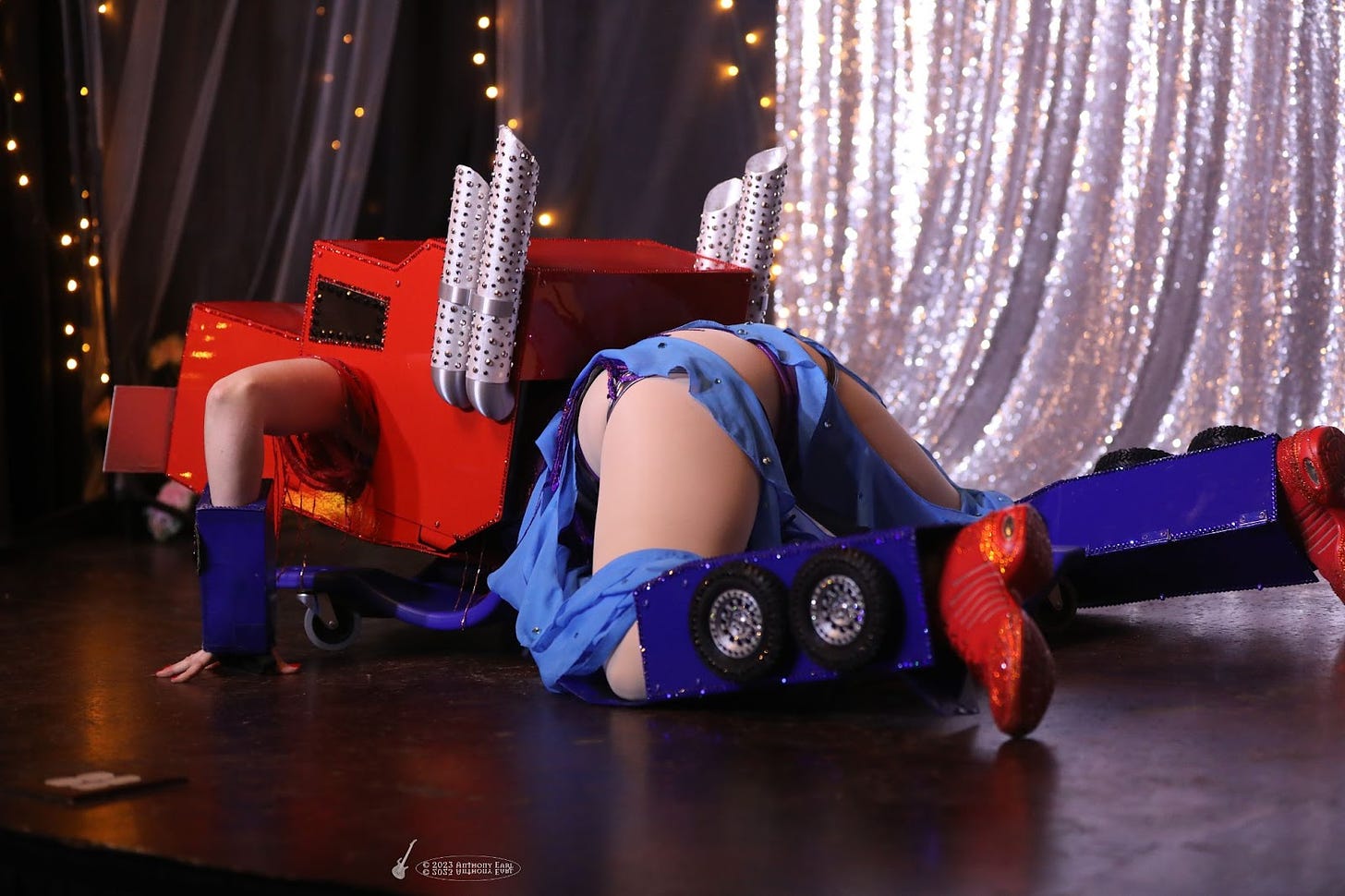
Burlesque? What a drag…
There’s an intrinsic connection between drag and burlesque, as these two arts were some of the most popular (and most mixed) in the early days of vaudeville, and they both do very similar things. Gender mockery, fuckery, and play with different expressions of sexuality is what both these arts are all about, as well as their creamy center of parody and impersonation. Burlesque and drag are also arts that are famously queer safe spaces, all through their history, and these days, nonbinary genders are flourishing in both these arts. Plus, draglesque is a very common sight in drag-only or burlesque-only shows today, showing how they’ve melded together as arts, almost to a point of them being the same thing now.
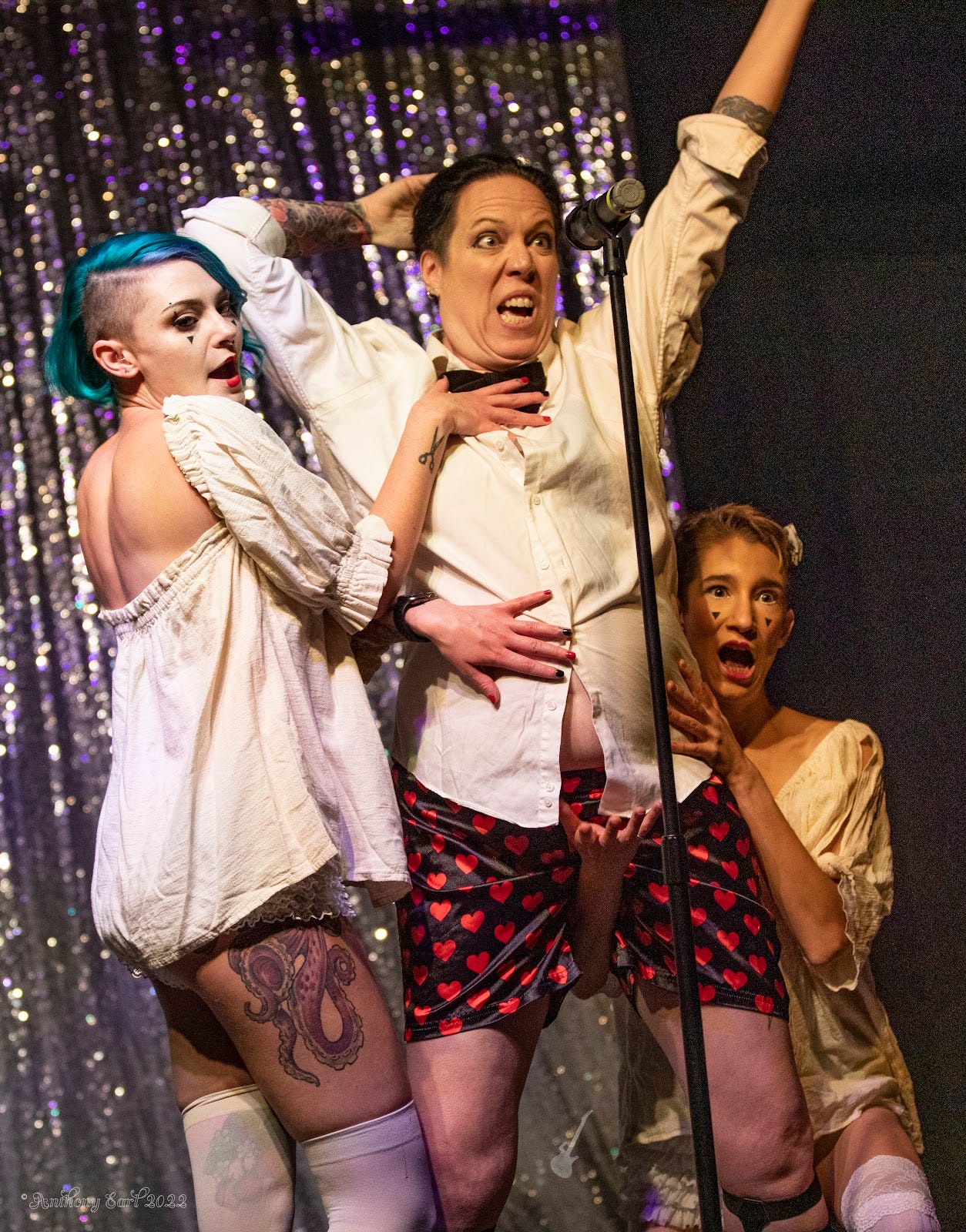
And now…Valkyrie Rose!
One of the first responsibilities incurred unto me when I first got into the art of burlesque was the composition of a stage name. The goal of a good stage name is a perfect combination of a double entendre, and something pinpointing the personality or style of the performer. I knew I wanted to incorporate something about warriorship in my stage name, as that’d been the focus of my movement and theatre worlds for decades.
The word for a woman ninja, from the classical Japanese martial arts I studied for many years, is kunoichi. But then I imagined a poor emcee trying to pronounce that, and thought I could do something better. Besides, I’m a huge white woman—and cultural appropriation isn’t exactly sexy. So, what’s a word for a giant white woman warrior? I thought briefly about making some kind of pun about booty and Boudicca, but failed. I considered maybe a famous pirate queen name, like Anne Bonny, but ehhh…
Then I thought: ooo I like vikings, especially the over-romanticized ones from media and folklore! How about a Valkyrie? Those are awesome—swooping down onto the battlefield to take fallen warriors to Valhalla? And they’re also connected to ravens, as well as beer? I’m in! Then I added Rose to my name, to connote my late-bloomer-ness and my blossoming as I emerged from my marriage. Valkyrie Rose. Not silly with innuendo as much as it could be, but. Still. Perfect.
I have, especially since co-producing and casting Blue Dime Cabaret shows since 2018, come across so many amazing and sometimes hilarious stage names. Here’s a list of some of my favorites: Katya Peepin, Blass Femme, Giselle Over, Panda MoanYum, Whiskey Ginger, and Dick Liqueur. There are more, but these are the ones I can think of off the top of my head.
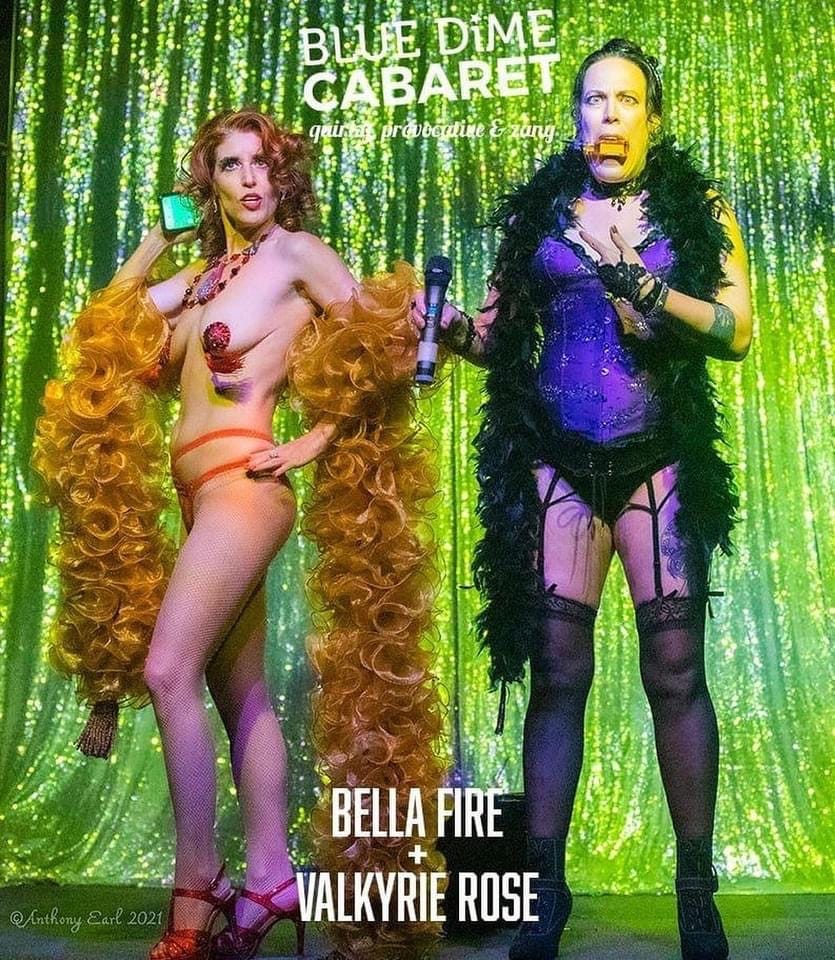
Conclusion: Inclusion
One of the biggest lessons I’ve learned from my time with burlesque is in the actual empowerment I encounter each time we put on a show; not only my own feelings myself, but in the feedback I get all the time from others who work with us and tell us how much a breath of fresh air we are compared to the catty diva pods around Denver that seem to be more the norm.
Diversity, inclusion of many differences to make a beautiful whole, is important in the making of good art, and burlesque uniquely can do this so well. For one thing, we at Blue Dime Cabaret have a zero tolerance policy for narcissistic behavior. Even before our opera singer left us for Austin, we made sure that diva nonsense had no place in our groups,* and I’ve heard so much feedback from n00bs and seasoned veterans alike that we’re a balm in a world where competition is fierce and scenes can be real bitchy. BDC shows in particular include representation of all kinds of bodies: big, small, curvy, angular; all genders you can think of and some you never heard of; old and young; and all ethnicities and skin colors. After all, what I call the ‘triumverate’: me, my co-producer Brandy, and our regular emcee and assistant producer Bella Fire, are all women in our 50s. In what other performing art form would women of our age be so celebrated and so frequently represented?
*This is just a joke about the word ‘diva’—our opera singer is a lovely, talented, generous, and gracious artist, who would combine her incredible skills at cosplay with her singing ability when she’d appear on our stages. Not a diva, except in the literal sense. Anyway.
But that’s not the only variety in our variety show—we’ve cultivated a spiritual inclusion as well. We’re all about actual empowerment, instead of just the lip service that so many other groups will, MLM-like, pretend to. Plus? Weirdness is required in all our shows, regardless of theme. I can’t tell you how many beautiful, together, classic burlesque pieces I’ve rejected over the years just because they’re too cute, lovely, basic, safe, normal. That’s not what we’re about. Once, after a hilariously strange performance of a Grinch who stripped down to green furry pasties and merkin, an audience member remarked he had a “confused boner.” We adopted this term as a manifesto of sorts.
I mean, I sort of kid—we definitely do have non-confusing sexy acts in our shows too, but the point is: our variety is real variety, and that’s what I, as casting director, think a good burlesque-heavy vaudeville show is all about.
[Is it gross if I advertise our next show, just in case you’re in Colorado in August? Ehh I’ll do it: the next Blue Dime Cabaret show is August 11 at dv8 distillery, and our theme is: Geeksville. All things nerd, including nerdlesque. Should be a blast.]
NOTE: photo credit for all these images is Anthony Earl. Each picture was taken during various Blue Dime Cabaret shows from 2021-2023. Graphics in the first and last pic by Brandy LeMae.




This is so cool and delightful! I never knew the details of burlesque, just that I liked the aesthetic from what I'd seen. :D Now I like it even more!